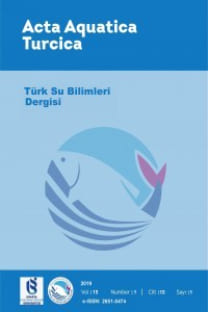Etiyopya'da Su Yönetiminin Durumu: Sorunlar ve Çözüm Yaklaşımları
Etiyopya, Nil Nehri, Su Tahsisi, Su Yönetimi, Su Kaynakları
The State of Water Management in Ethiopia: Problems and Solution Approaches
Ethiopia, Nile River, Water Allocation, Water Management, Water Resources,
___
- Anonymous, (2019). Impacts of the dam. https://www.voanews.com/usa/trump-meets-egypt-ethiopia-sudanfmsabout-dam-feud Anonymous, (2020). Regions of Ethiopia. https://en.wikipedia.org/wiki/Regions_of_Ethiopia Asit K. Biswas., (2008). Integrated Water Resources Management: Is It Working? International Journal of Water Resources Development, 24:1, 5-22.
- Awulachew, S. B. Yilma, A. D. Loulseged, M. Loiskandl, W. Ayana, M. & Alamirew, T. (2007). Water resources and irrigation development in Ethiopia. Vol. 123.
- Bilen, Ö. (1997). Turkey and water issues in the Middle East. Southeastern Anatolia Project (GAP) Regional Development Administration.
- Bilen, Ö. (2009). Ortadoğu su sorunları ve Türkiye. TESAV, Toplumsal, Ekonomik, Siyasal Araştırmalar Vakfı.
- Biswas, A. K., Tortajada, C., & Izquierdo-Avino, R. (Eds.). (2009). Water management in 2020 and beyond. Berlin: Springer.
- Central Intelligence Agency (CIA), (2019). The World Fact Book. https://www.cia.gov/library/publications/theworld-factbook/
- ES, 2013. Ethiopian Standards. 261:2001. National Drinking Water Quality Monitoring and Surveillance Strategy Ministry of Health. Addis Ababa, Ethiopia.
- EWNHS, (2018). Ethiopian Wildlife and Natural History Society and Wetlands International, A First Directory of Ethiopian Wetlands: Descriptions, Ecosystem Services, Causes of Degradation & Recommendations for Restoration and Sustainability. Eclipse Printing and Graphics.
- FDRE, (1995). Constitution of the Federal Democratic Republic of Ethiopia. Federal Negarit Gazetta, 1(1), 40- 45.
- FNGoE, (2000). Ethiopian Water Resources Management, Proclamation No: 197/2000.Federal Negarit Gazeta of Etiopia.
- Libhaber, M. & Jaramillo, A.O., (2012). Sustainable Treatment and Reuse of Municipal Wastewater. IWA Publishing.
- Loucks, D. P., & Van Beek, E. (2017). Water resource systems planning and management: An introduction to methods, models, and applications. Springer.
- MoWR, (2002). Ministry of Water Resource. Water Sector Development Program. Main report II. NGoE, (1994). Proclamation to Provide for The Utilization of Water Resources. Proclamation No. 92/1994,
- Negarit Gazeta of the Transitional Government of Ethiopia. Prasifka David W., (1994). Water Supply Planning. Kreiger publishing company.
- Rowan, C. (2009). The politics of water in Africa: the European Union's role in development aid partnership. Vol. 24. IB Tauris.
- Schelwald-van der Kley, A. L., & Reijerkerk, L. (2009). Water: A way of life: Sustainable water management in a cultural context. CRC Press.
- Schlesinger, W.H., Reckhow, K.H., Bernhardt, E.S., 2006. Global change: the nitrogen cycle and rivers. Water Resources Research. 42 (3).
- Scudder, T. T. (2012). The future of large dams: Dealing with social, environmental, institutional and political costs. Taylor & Francis.
- Stonestrom, D.A., Scanlon, B.R., Zhang, L., 2009. Introduction to special section on impacts of land use change on water resources. Water Resources Research 45 (7).
- Teshager, A.D., Gassman, P.W., Schoof, J.T., 2016. Assessment of impacts of agricultural and climate change scenarios on watershed water quantity and quality, and crop production. Hydrol. Earth Syst. Sci. 20 (8), 3325 UN-WBCSD, 2006. WBCSD Report on Facts and trends of water. ISBN: 2-940240-70-1. Switzerland.
- Tortajada, C.& K Biswas, A., (2009). Water Resources Development and Management. Springer. UNEP, (2002). United Nations Environment Programme. Vital water graphics: an overview of the state of the world's fresh and marine waters. Earthprint.
- UNEP, (2010). United Nations Environment Programme. Africa Water Atlas. ISBN: 978-92-807-3110.
- Valentin, C., Agus, F., Alamban, R., Boosaner, A., Bricquet, J., Chaplot, V., De Guzman, T., De Rouw, A., Janeau, J., Orange, D., 2008. Runoff and sediment losses from 27 upland catchments in Southeast Asia: impact of rapid land use changes and conservation practices. Agriculture, Ecosystem & Environment 128 (4), 225–238.
- Varis, O., Tortajada, C., & Biswas, A. K., (2008). Management of transboundary rivers and lakes. Springer. Veettil, A.V., Mishra, A.K., 2016. Water security assessment using blue and green water footprint concepts. Jouranl of Hydrology. 542, 589–602.
- Wada, Y., Van Beek, L.P., Wanders, N., Bierkens, M.F., 2013. Human water consumption intensifies hydrological drought worldwide. Environmental Research Letters. 8, 034036.
- World Bank, (2019). Population total, Ethiopia. https://data.worldbank.org/indicator/SP.POP.TOTL?locations=ET
- WWAP, (2012). World Water Assessment Programme. The United Nation World Water Development Report 4: Managing Water Under Uncertainty and Risk. UNESCO.
- Yayın Aralığı: 4
- Başlangıç: 1988
- Yayıncı: Yunus Ömer BOYACI
Amel ALLALGUA, Amel MENASRIA, Wahiba MOUAISSIA, Mourad BENSOUILAH, Nouha KAOUACHI
Fajların Balık Hastalıklarının Kontrolünde Kullanımı
Süheyla KARATAŞ STEINUM, Fatma KARAÇOBAN
Etiyopya'da Su Yönetiminin Durumu: Sorunlar ve Çözüm Yaklaşımları
Awol Kedir JEWARO, İbrahim DİLER
Amel ALLALGUA, Amel MENASRIA, Wahiba MOUAISSIA, Mourad BENSOUILAH, Nouha KAOUACHI
Trachipterus trachypterus'un (Gmelin, 1789) Antalya Körfezi'nde (Turkiye) İlk Kaydı
Mehmet GÖKOĞLU, Mehmet Rüştü ÖZEN
Gülşen ULUKÖY, Ayşegül KUBİLAY, Pınar YILDIRIM, Ahmet DURU, Tom WİKLUND
Mustafa KOYUN, Ataman Altuğ ATICI
Cemalettin ŞAHİN, Erhan ÖZTÜRK, Muhammet EMANET, Yusuf CEYLAN
